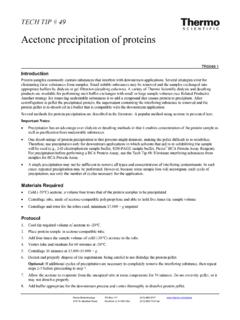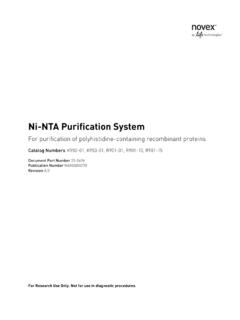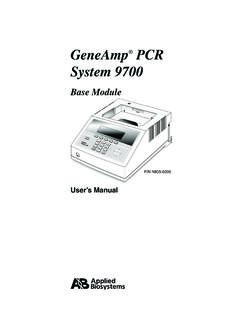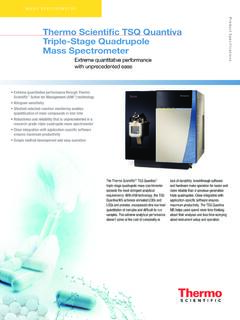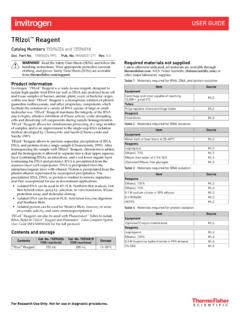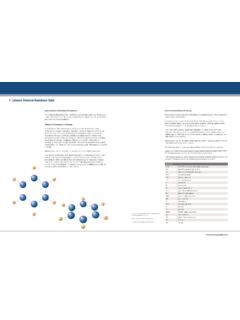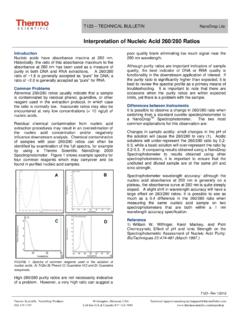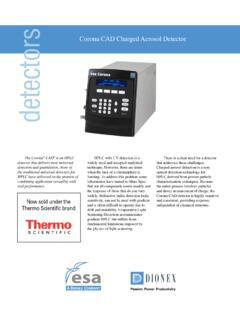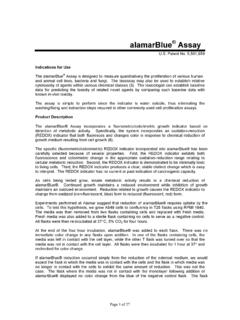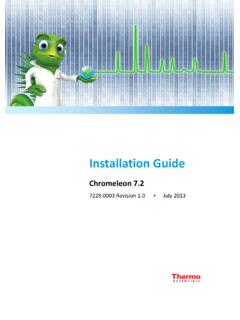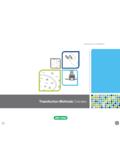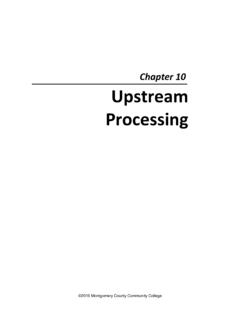Transcription of pcDNA™3.1(+) pcDNA™3.1(–) - tools.thermofisher.com
1 PcDNA (+). pcDNA ( ). Catalog nos. V790-20 and V795-20. Version K. 10 November 2010. 28-0104. Corporate Headquarters Invitrogen Corporation 1600 Faraday Avenue Carlsbad, CA 92008. T: 1 760 603 7200. F: 1 760 602 6500. User Manual E: For country-specific contact information visit our web site at ii Table of Contents Important Accessory Products ..vi methods .. 1. overview .. 1. Cloning into pcDNA .. 2. Transfection .. 6. Creating Stable Cell Lines .. 7. 10. pcDNA Vectors .. 10. pcDNA 12. Technical 13. Purchaser Notification .. 13. References .. 15. iii iv Important Information pcDNA This manual is supplied with the following products. Vectors Product Catalog no.. pcDNA (+) Vector V790-20.
2 PcDNA ( ) Vector V795-20. Shipping and Vectors are shipped on wet ice. Upon receipt, store at Storage 20 C. Contents The pcDNA vector components pcDNA are listed below: Item Concentration Volume . pcDNA Vector 20 g at g/ l, in TE buffer, pH 40 l . pcDNA (+) or (10 mM Tris-HCl, 1 mM EDTA, pH ). pcDNA ( ). Control Plasmid 20 g at g/ l, in TE buffer, pH 40 l pcDNA (10 mM Tris-HCl, 1 mM EDTA, pH ). Product The Certificate of Analysis provides detailed quality control information for each Qualification product. Certificates of Analysis are available on our website. Go to and search for the Certificate of Analysis by product lot number, which is printed on the box. v Accessory Products Additional Additional products that may be used with the pcDNA vectors are available from Products Invitrogen.
3 Ordering information is provided below. Product Amount Catalog no. One Shot TOP10 Chemically 10 reactions C4040-10. Competent Cells 20 reactions C4040-03. One Shot TOP10F' Chemically 20 reactions C3030-03. Competent Cells 40 reactions C3030-06.. Lipofectamine 2000 ml 11668-019. ml 11668-027.. Geneticin 1g 11811-023. 5g 11811-031.. PureLink HQ Mini Plasmid 100 preps K2100-01. Purification Kit PureLink HiPure Plasmid 25 preps K2100-04. Midiprep Kit vi methods overview Description pcDNA (+) and pcDNA ( ) are kb vectors derived from pcDNA 3 and designed for high-level stable and transient expression in mammalian hosts. High- level stable and non-replicative transient expression can be carried out in most mammalian cells.
4 The vectors contain the following elements: Human cytomegalovirus immediate-early (CMV) promoter for high-level expression in a wide range of mammalian cells Multiple cloning sites in the forward (+) and reverse ( ) orientations to facilitate cloning Neomycin resistance gene for selection of stable cell lines Episomal replication in cells lines that are latently infected with SV40 or that express the SV40 large T antigen ( COS-1, COS-7). The control plasmid, pcDNA , is included for use as a positive control for transfection and expression in the cell line of choice. Experimental Use the following outline to clone and express your gene of interest in pcDNA Outline 1. Consult the multiple cloning sites described on pages 3-4 to design a strategy to clone your gene into pcDNA 2.
5 Ligate your insert into the appropriate vector and transform into E. coli. Select transformants on LB plates containing 50 100 g/ml ampicillin. 3. Analyze your transformants for the presence of insert by restriction digestion. 4. Select a transformant with the correct restriction pattern and use sequencing to confirm that your gene is cloned in the proper orientation. 5. Transfect your construct into the mammalian cell line of interest using your own method of choice. Generate a stable cell line, if desired. 6. Test for expression of your recombinant gene by western blot analysis or functional assay. 1. Cloning into pcDNA Introduction Diagrams are provided on pages 3-4 to help you design a cloning strategy for ligating your gene of interest into pcDNA General considerations for cloning and transformation are listed below.
6 General For help with DNA ligations, E. coli transformations, restriction enzyme analysis, Molecular purification of single-stranded DNA, DNA sequencing, and DNA biochemistry, Biology please refer to Molecular Cloning: A Laboratory Manual (Sambrook et al., 1989) or Techniques Current Protocols in Molecular Biology (Ausubel et al., 1994). E. coli Strain Many E. coli strains are suitable for the propagation of this vector including TOP10F , DH5 -T1R, and TOP10. We recommend that you propagate vectors containing inserts in E. coli strains that are recombination deficient (recA) and endonuclease A-deficient (endA). If you wish to express a human gene of interest from pcDNA , we recommend using an Ultimate Human ORF (hORF) Clone available from Invitrogen.
7 For more information about the Ultimate hORF Clones available, refer to our Web site ( ) or contact Technical Support (page 13). Transformation You may use any method of your choice for transformation. Chemical Method transformation is the most convenient for most researchers. Electroporation is the most efficient and the method of choice for large plasmids. Maintenance of To propagate and maintain pcDNA , use 10 ng of vector to transform a recA, pcDNA endA E. coli strain like TOP10F , DH5 -T1R, TOP10, or equivalent. Select transformants on LB plates containing 50 100 g/ml ampicillin. Be sure to prepare a glycerol stock of your plasmid-containing E. coli strain for long-term storage (see page 5).
8 Cloning pcDNA (+) and pcDNA ( ) are non-fusion vectors. Your insert should Considerations contain a Kozak translation initiation sequence with an ATG initiation codon for proper initiation of translation (Kozak, 1987; Kozak, 1991; Kozak, 1990). An example of a Kozak consensus sequence is provided below. Other sequences are possible, but the G or A at position 3 and the G at position +4 (shown in bold). illustrates the most commonly occurring sequence with strong consensus. Replacing one of the two bases at these positions provides moderate consensus, while having neither results in weak consensus. The ATG initiation codon is shown underlined. (G/A)NNATGG. Your insert must also contain a stop codon for proper termination of your gene.
9 Please note that the Xba I site contains an internal stop codon (TCTAGA). continued on next page 2. Cloning into pcDNA , continued Multiple Cloning Below is the multiple cloning site for pcDNA (+). Restriction sites are labeled Site of to indicate the cleavage site. The Xba I site contains an internal stop codon pcDNA (+) (TCTAGA). The multiple cloning site has been confirmed by sequencing and functional testing. The complete sequence of pcDNA (+) is available for downloading from our web site ( ) or from Technical Support (see page 13). For a map and a description of the features of pcDNA (+), please refer to the Appendix, pages 10-11. enhancer region (3 end). 689 CATTGACGTC AATGGGAGTT TGTTTTGGCA CCAAAATCAA CGGGACTTTC CAAAATGTCG.
10 CAAT TATA. 749 TAACAACTCC GCCCCATTGA CGCAAATGGG CGGTAGGCGT GTACGGTGGG AGGTCTATAT. 3' end of hCMV. putative transcriptional start 809 AAGCAGAGCT CTCTGGCTAA CTAGAGAACC CACTGCTTAC TGGCTTATCG AAATTAATAC. T7 promoter/primer binding site Nhe I Pme I Afl II Hind III Asp718 I Kpn I. 869 GACTCACTAT AGGGAGACCC AAGCTGGCTA GCGTTTAAAC TTAAGCTTGG TACCGAGCTC. BamH I BstX I* EcoR I EcoR V BstX I* Not I Xho I. 929 GGATCCACTA GTCCAGTGTG GTGGAATTCT GCAGATATCC AGCACAGTGG CGGCCGCTCG. Xba I Apa I Pme I reverse priming site 989 AGTCTAGAGG GCCCGTTTAA ACCCGCTGAT CAGCCTCGAC TGTGCCTTCT AGTTGCCAGC. 1049 CATCTGTTGT TTGCCCCTCC CCCGTGCCTT CCTTGACCCT GGAAGGTGCC ACTCCCACTG. BGH poly (A) site 1109 TCCTTTCCTA ATAAAATGAG GAAATTGCAT.
